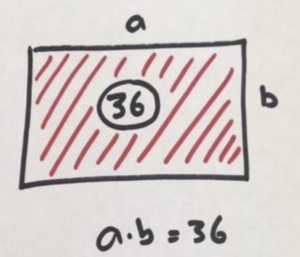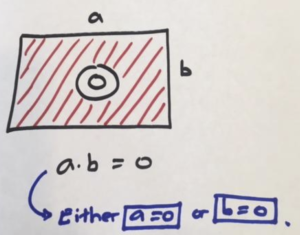Quadratics
3.2 Factoring = Breaking Symmetry
Lesson materials located below the video overview.
SETTING THE SCENE
Recall that we started our story of symmetry with a rectangle of area 36.

Without any further detail, we can say nothing about the width and length \(a\) and \(b\) of that rectangle: maybe it’s a 4-by-9 or a 2-by-18 or a 45-by-0.08 rectangle. We can’t know.
But if we add the word “symmetrical” to our description of the rectangle, then we know something about the values \(a\) and \(b\): they must each be 6.
But there is one other instance where one could say something about the side lengths of a given rectangle.
Suppose I gave you a rectangle and told you it had ZERO AREA.

Then you would say that the picture is wrong and that we should have drawn a “rectangle” with either zero width or zero length. That is, we’d deduce that either \(a=0\) or \(b=0\).
People have observed that this one special case, of having a rectangle of zero area, can be used to solve some certain quadratics—if we are lucky!
This essay shows how.
READ MORE HERE: QUADRATICS PD Essay 3.2
(See too Edfinity.com/XXX for a robust source of curriculum practice problems for you collate, organise, and use.)
Resources
Books
Take your understanding to the next level with easy to understand books by James Tanton.
BROWSE BOOKS![]()
Guides & Solutions
Dive deeper into key topics through detailed, easy to follow guides and solution sets.
BROWSE GUIDES![]()
Donations
Consider supporting G'Day Math! with a donation, of any amount.
Your support is so much appreciated and enables the continued creation of great course content. Thanks!
Ready to Help?
Donations can be made via PayPal and major credit cards. A PayPal account is not required. Many thanks!
DONATE![]()


